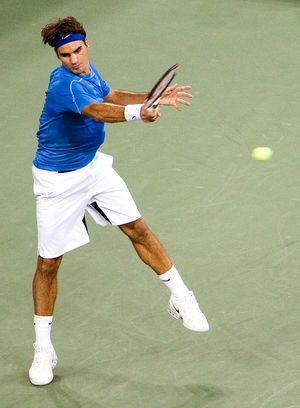CZ:Featured article/Current: Difference between revisions
imported>Chunbum Park mNo edit summary |
imported>Chunbum Park (tennis) |
||
| Line 1: | Line 1: | ||
{{ | [[Image:Roger_Federer.jpg|thumb|left|{{#ifexist:Template:Roger Federer.jpg/credit|{{Roger Federer.jpg/credit}}<br/>|}}Roger Federer, a professional tennis player, hitting a forehand against James Blake in the quarterfinals of the 2006 U.S. Open.]] | ||
'''Tennis''' is a sport played between either two players ("singles") or two teams of two players ("doubles"). Players use a stringed racquet to strike a hollow rubber ball covered with felt over a net into the opponent's court. In some places tennis is still called '''lawn tennis''' to distinguish it from ''real tennis'' (also known as ''royal tennis'' or ''court tennis''), an older form of the game that originated in France in the Middle Ages and is played indoors on a very different court. Originating in England in the late nineteenth century, lawn tennis first spread throughout the English-speaking world, particularly among the upper classes. Today tennis is an Olympic sport that is played at all levels of society, by all ages, and in many countries around the world. Except for the adoption of the tie-breaker in the 1970s, its rules have remained remarkably unchanged since the 1890s. Millions of people also follow tennis as a spectator sport, especially the four Grand Slam tournaments. | |||
The | ==Manner of play== | ||
===The court=== | |||
Tennis is played on a rectangular, flat surface that can be composed of various materials. The court is 78 feet (23.77 meters) long and its width is 27 feet (8.23 m) for singles matches and 36 feet (10.97 m) for doubles matches. Additional clear space around the court is required in order for players to reach balls. A net is stretched across the full width of the court, parallel with the baselines, dividing it into two equal areas. The net is 3 feet 6 inches (1.07 m) high at the posts and 3 feet (914 mm) high in the center. | |||
====''The lines''==== | |||
The two lines that delineate the width of the court are called the baseline. The short mark in the center of each baseline is referred to as either the hash mark or the center mark. The outermost lines that make up the length are both called the doubles sideline. These are the boundaries used when doubles is being played. The area between the doubles sideline and the lines next to them is called the doubles alley, which is considered to be "out" in singles play. These lines next to the doubles sideline are the singles sidelines, and are used as boundaries in singles play. The line that runs across the center of a player's side of the court is called the service line; despite its name this is not where a player legally stands when making a serve. The line dividing the service line in two is called the center line or center service line. The boxes that this center line creates are called the service boxes; depending on a player's position, they will have to hit the ball into one of these when serving. | |||
The | |||
Revision as of 14:41, 2 July 2011
Tennis is a sport played between either two players ("singles") or two teams of two players ("doubles"). Players use a stringed racquet to strike a hollow rubber ball covered with felt over a net into the opponent's court. In some places tennis is still called lawn tennis to distinguish it from real tennis (also known as royal tennis or court tennis), an older form of the game that originated in France in the Middle Ages and is played indoors on a very different court. Originating in England in the late nineteenth century, lawn tennis first spread throughout the English-speaking world, particularly among the upper classes. Today tennis is an Olympic sport that is played at all levels of society, by all ages, and in many countries around the world. Except for the adoption of the tie-breaker in the 1970s, its rules have remained remarkably unchanged since the 1890s. Millions of people also follow tennis as a spectator sport, especially the four Grand Slam tournaments.
Manner of play
The court
Tennis is played on a rectangular, flat surface that can be composed of various materials. The court is 78 feet (23.77 meters) long and its width is 27 feet (8.23 m) for singles matches and 36 feet (10.97 m) for doubles matches. Additional clear space around the court is required in order for players to reach balls. A net is stretched across the full width of the court, parallel with the baselines, dividing it into two equal areas. The net is 3 feet 6 inches (1.07 m) high at the posts and 3 feet (914 mm) high in the center.
The lines
The two lines that delineate the width of the court are called the baseline. The short mark in the center of each baseline is referred to as either the hash mark or the center mark. The outermost lines that make up the length are both called the doubles sideline. These are the boundaries used when doubles is being played. The area between the doubles sideline and the lines next to them is called the doubles alley, which is considered to be "out" in singles play. These lines next to the doubles sideline are the singles sidelines, and are used as boundaries in singles play. The line that runs across the center of a player's side of the court is called the service line; despite its name this is not where a player legally stands when making a serve. The line dividing the service line in two is called the center line or center service line. The boxes that this center line creates are called the service boxes; depending on a player's position, they will have to hit the ball into one of these when serving.
